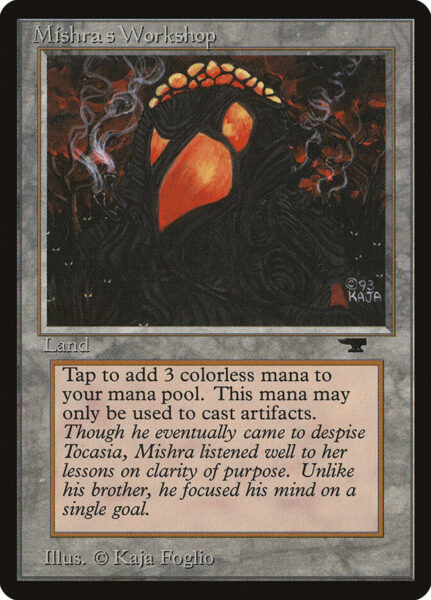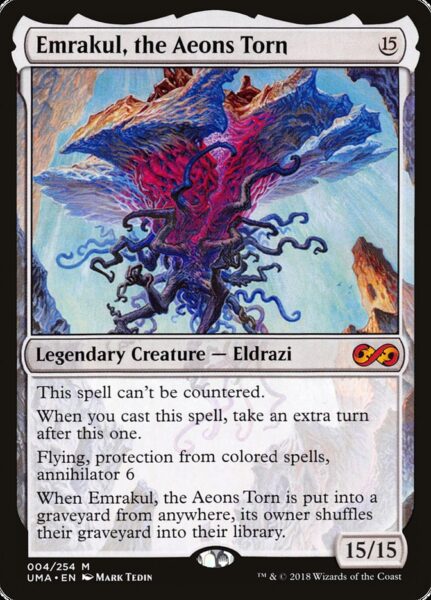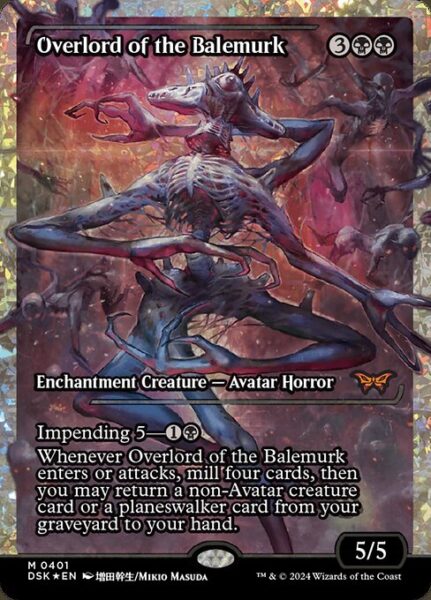by Johnny Cycles, September 19th, 2025

Antiquities Revisited
March 4th, 1994, three months after Magic’s first expansion set, Arabian Nights, took players to the magical and mystical desert of 1000 and one Nights, Antiquities was released.

The set is based on The Brothers’ War between Mishra and Urza, who fought over two halves of a stone they discovered in the Caves of Koilos, the Mightstone and the Weakstone. This should be familiar to contemporary players as Wizards revisited the story in the recent set, The Brothers’ War.
Otherwise, Antiquities is most well-known now today as the set that gave us the Tron lands.

Its set symbol is an anvil and booster packs came with a whopping 8 cards – 6 commons, 2 uncommons, and, according to the internet, 1 rare. How that equals 8, I’ll never know, but math is not my strong suit…
Antiquities was the first set to include the same card with alternate art. The Tron lands, Strip Mine, and Mishra’s Factory have several variants each.
Antiquities is designed around artifacts. Of the 100 cards that make up the set, 44 are artifacts. The remainder, excluding the lands, which all produce colorless mana, reference artifacts in the text box or the flavor text.
I remember all these artifacts turned me off as a teenager in the 90s. They felt too modern, too much like technology, and Magic, for me, was a world of fantasy. Dragons and swords, yes. automatons and metal birds, no.
And I don’t think I was alone in feeling this way. Remember, at the time, Magic players were only playing cards from Alpha, Beta, and Unlimited, which were almost entirely the same, and Arabian Nights. Each set had artifacts, of course, but not to the same degree as Antiquities. It was easy to overlook a card like Brass Man in favor of Flying Carpet or City in a Bottle.
Dragons? Yes! Whatever that metal thing is? No, thank you!
When Antiquities was released, Magic was more fantasy than science fiction. With the printing of so many artifacts in this set, that balance felt like it was changing.
If only that teenager could see the world of Magic today, with its televisions, race cars, and Spider Man…
Of course, all of that is just the memory of a casual player’s impressions of the set.
How did the more competitive Magic community view Antiquities? For that, let’s take a look at some tournament results.

Antiquities in Competitive Play
Antiquities was legal for Magic’s first Worlds tournament in 1994 (August 19-21). Unlike Arabian Nights, though, which saw many of its cards heavily played, Antiquities was not as represented.
By far the two most played cards from the set were Mishra’s Factory and Strip Mine, with 8 copies of the former and 5 copies of the latter appearing in the top 4 decks. The winning deck, piloted by Zak Dollan, ran two copies of Strip Mine.
Otherwise, the only other card from Antiquities to see play in this tournament was Crumble in the sideboard of the fourth place deck.
Of course, this was the time of moxen and Black Lotus, the best artifacts ever printed. It’s unsurprising that a set built around artifacts considerably less powerful than these wasn’t largely represented.

Antiquities Today
But what of the set today? Which cards still see play?
Lands
1994 tournament results don’t lie…
Strip Mine is still one of the most recognized cards from Antiquities. It would be one of the most played except that it’s banned in Legacy and restricted in Vintage. Meanwhile, it appears in less than 3% of Commander decks, probably because people hate playing against land destruction.
The Tron lands are surely the most played cards from the set. They are the cornerstone of the Tron archetype that shows up in all the formats they’re legal in.
Mishra’s Factory is still being printed in Masters sets and Commander precons alike. It’s also worth noting that it is Magic’s first creature land.
And finally, there’s Mishra’s Workshop, the sets most expensive card, coming in at around $3000.

Other Cards of Note
Ornithopter is probably one of the most played cards today from Antiquities. It’s a 4-of in nearly every Affinity deck.
Hurkyl’s Recall sees sideboard play in Modern…or in the main deck of my Affinity Aristocrats deck featuring Weapons Manufacturing.

The Rack is still played in Modern, even if not in a tier 1 deck.

Ashnod’s Altar is a Commander staple in sacrifice decks. Even as an uncommon, the cheapest copy will set you back $8.

Millstone gave Magic players the first tool of the polarizing strategy of winning by emptying your opponent’s library.
Artifact Matters Cycles in the Set
Each color besides White was given a card that let them sacrifice an artifact for advantage.
Orcish Mechanics is a repeatable shock at the cost of an artifact, Dwarven Weaponsmith grows a creature.

Priest of Yawgmoth is mana ramp for black.

Blue gets card draw with Sage of Lat-Nam.
What happened to White’s card? I’m not sure. Maybe the cycle was finished in a later set, but in Antiquities, White got ways to protect artifacts in Argivian Blacksmith and ways to recur them from the graveyard in Argivian Archaeologist.

Ashnod’s Altar can be seen as giving artifacts their own card in the cycle. But instead of sacrificing one of their own for value, it sacrifices any creature.
Creatures Used to Suck!!!
Man, creatures used to be real bad. Check out this beauty.

6 mana for a 6/6 flying first striker would probably make the cut for an uncommon in today’s Magic. Throw in that horrible, horrible drawback, and this card is next to unplayable.
But that art!

Cards I Want to Build Around in Commander…
Titania’s Song is an intriguing way of making our non-creature artifacts into creatures. Surely there is a deck that can abuse this effect.
Strange Cards
The set features its fair share of strange cards, but a few are worth mentioning.

Golgothian Sylex continues the early and short-lived trend of cards that hate on specific sets.

Tetravus comes in play with 3 +1/+1 counters. During your upkeep, you can remove any number of counters and put that many 1/1 flying artifact creatures into play.
So far, that seems pretty normal.
The card’s uniqueness is twofold. First, you can also put counters back on Tetravus by exiling the artifact creatures you made on an earlier turn. Second, those artifact tokens you make by removing a counter can’t be enchanted…
I wonder if there is another card in Magic that does all of these things alongside such a strange restriction… Shoot, I wonder if there is another card that says, this card can’t be enchanted. Let me know in the comments!
Craziest Art

Ashnod’s Transmogrant… not sure this needs further explanation.

Shout out to Atog, which apparently was a meme before memes were a thing. I must have missed out on this time in Magic’s history, but the internet says Atog has its own following, basically, and we all know the internet is never wrong.
Flavor Wins
Much like Arabian Nights, Antiquities has a lot of great flavor. Of the many to choose from, these are the ones I really liked.

Dwarven Weaponsmith – taking the metal of an artifact to improve the weapons of a creature is a great flavor ability.

Battering Ram is another unique card whose abilities perfectly match what it is and does.

Finally, Rocket Launcher. Even as early as 1994, Magic included modern weaponry… What a terrible card but what great flavor!
Banned Cards
While the set didn’t get any cards outright banned outside of the ante card, Bronze Tablet, several were restricted a few months after release.
These are:
Feldon’s Cane, Candelabra of Tawnos, Ivory Tower, and Mishra’s Workshop.
Conclusion
And that’s my set review for Antiquities, Magic’s second expansion set.
If you played Magic when this set was released, what was your reaction to it? Were you as put off by it as I was? Or did you love the artifact direction? Let me know in the comments!
Up next in the series…Legends!




















